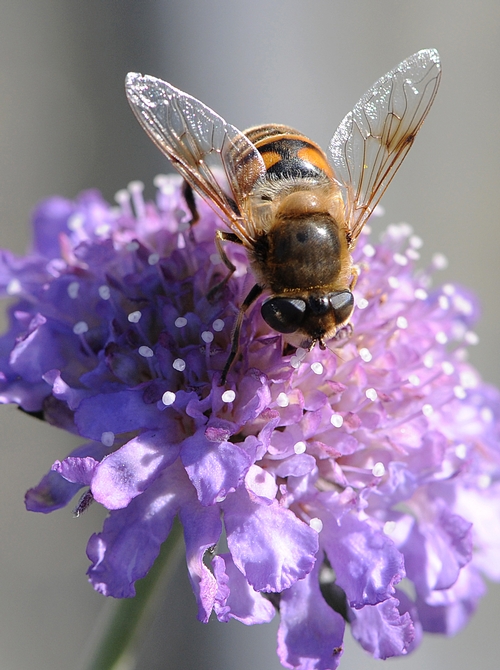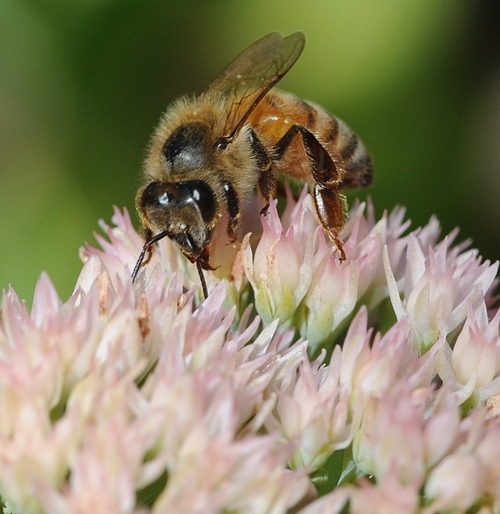- Author: Kathy Keatley Garvey
It's Friday Fly Day, and time to post an image of a fly that masquerades as a bee.
That would be "the bee fly," a fly so named because it resembles a bee
Order: Diptera. Family: Bombyliidae.
In its adult stage, it's a pollinator that feeds on nectar and pollen. In its larval stage, it's parasitoid. The adult bee fly lays her eggs in the nests of wasps, beetles or solitary bees and the developing larvae eat their host.
"The Bombyliidae include at least 4,500 described species, and certainly thousands more remain to be described," Wikipedia tells us. "However, most species do not often appear in abundance, and compared to other major groups of pollinators they are much less likely to visit flowering plants in urban parks or suburban gardens. As a result, this is arguably one of the most poorly known families of insects relative to its species richness. The family has a patchy fossil record, with species being known from a handful of localities the oldest known species are known from the Middle Cretaceous Burmese amber, around 99 million years old."
Bee flies have also acquired the nickname of "bomber flies." That because when the adult female is ready to "gift" a host with her eggs, she hovers over the burrow in mid-air and flicks her eggs.
Aren't insects amazing?
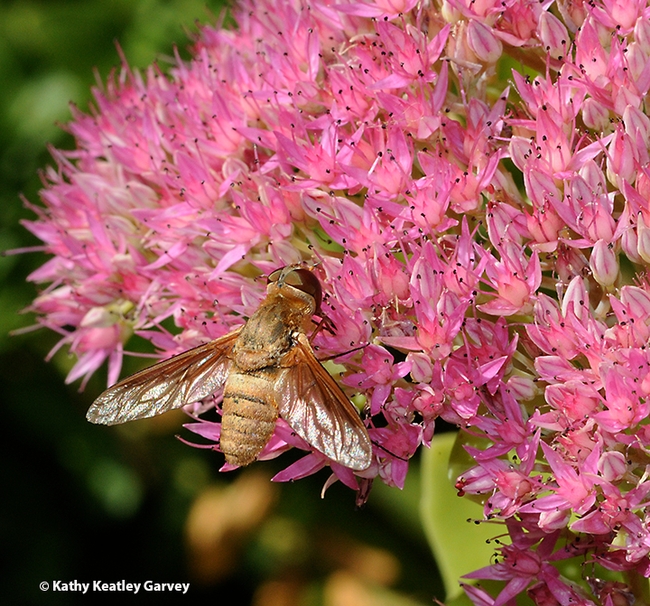
- Author: Kathy Keatley Garvey
If you've ever watched a Gray Hairstreak butterfly (Strymon melinus) nectaring a sedum, and then watched a honey bee (Apis mellifera) land on the same flower, it's a study in sharing.
"I was here first," says the Gray Hairstreak, sipping nectar.
"I was here second," says the honey bee.
So they wind up sharing, the butterfly and the honey bee. It's autumn and there's not much nectar anywhere.
"Stay back," says the butterfly.
"No," says the honey bee. "My colony needs the nectar."
So they crawl slowly on the blossom, meeting head to head, as if to prove that yes, "We can all get along."
The Gray Hairstreak is not so sure. The honey bee abruptly moves closer, and the startled butterfly lifts off to find another blossom.
The butterfly will be first again on a nearby sedum.


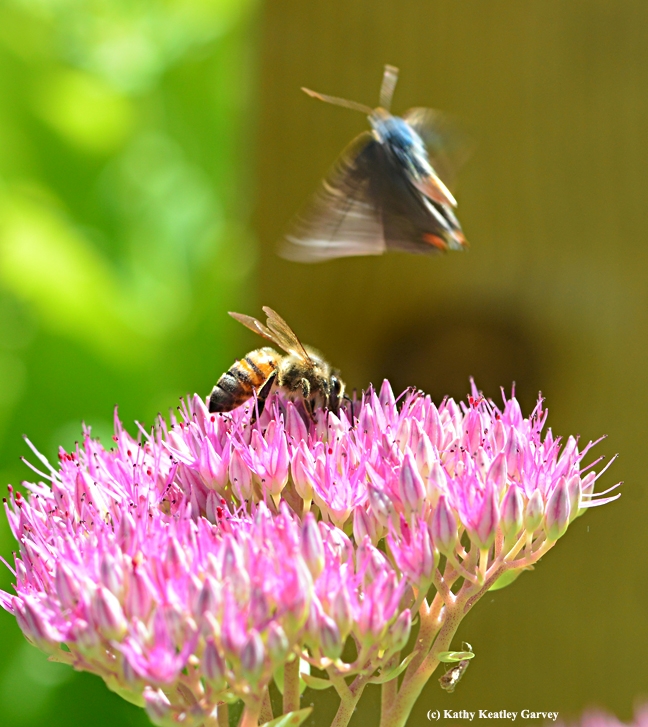
- Author: Kathy Keatley Garvey
A miss is as good as a mile...or a smile.
The Buckeye (Junonia coenia) is a striking butterfly patterned with eyespots and white bars. We saw one today nectaring on sedum, but with chunks of a wing missing. Perhaps a bird or a praying mantis tried to grab it. It narrowly escaped predation.
A lucky day.
It's quite a common butterfly, as common as it is recognizable.
The Buckeye "is found in southern Manitoba, Ontario, Quebec and Nova Scotia and all parts of the United States, except the Northwest," according to Wikpedia. It's also found throughout Central America and Colombia.
"The Buckeye breeds on plants containing bitter iridoid glycosides, including plantains (Plantago, especially P. lanceolata), various Scrophulariaceae (especially Fluellin, Kickxia), and Lippia (Lippia or Phyla nodiflora)," says butterfly expert Art Shapiro, UC Davis distinguished professor of evolution and ecology, on his website. "The spiny, black-and-white caterpillar has a bright orange head. Its behavior suggests its diet makes it virtually immune to vertebrate predation, but the pupa and adult are quite edible."
Well, this is one adult that got away.
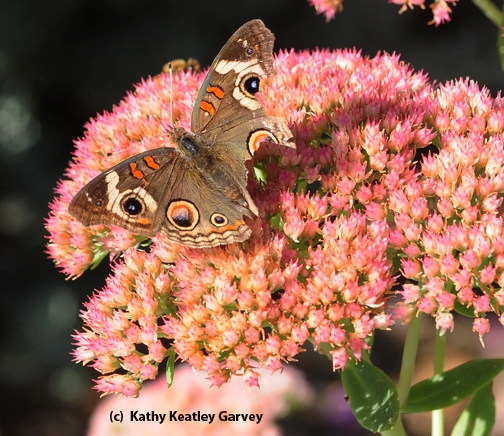


- Author: Kathy Keatley Garvey
if it's a streak of gray, you don't wash it away.
You welcome it.
The gray hairstreak butterfly (Strymon melinus) is common on our sedum, a good fall plant for pollinators, including butterflies, honey bees, sweat bees and syrphid flies, aka hover flies or flower flies.
Butterfly expert Art Shapiro, distinguished professor of evolution and ecology at the University of California, Davis, says on his website that the gray hairstreak visits "an immense variety of flowers, both wild and cultivated. They are particularly addicted to Heliotrope and white-flowered Apiaceae."
Apiaceae? That's the carrot family, which includes not only carrots but parsley, celery, Queen Ann'es lace, parsnip, cilantro, hemlock, fennel and anise. Heliotropes, which commonly yield pink-purple flowers, are good for graystreaks, but not good for horses. It's toxic and can induce liver failure, according to the ASPCA's Animal Poison Control Center.
You can't be too careful out there.


- Author: Kathy Keatley Garvey
"If it looks like a duck, quacks like a duck, and walks like a duck, it's probably a duck," or so the saying goes.
But if it looks like a honey bee, moves around on blossoms like a honey bee, and feeds on nectar and pollen like a honey bee, it may not be a honey bee.
It could be a flower fly or syrphid in the Syrphidae family.
The syrphids suffer from multiple cases of mistaken identity.
One of the syprhids commonly mistaken for a honey bee (Apis mellifera) is the drone fly (Eristalis tenax).
An imposter!
We spotted a drone fly--the first we've seen this year--on Feb. 5 in Tomales, Marin County. It was nectaring a pincushion flower (Seabiosa columbaria) at the Mostly Natives Nursery.
"There's a bee!" someone exclaimed.
It wasn't. It was a drone fly.
In its larval stage, it's known as a rat-tailed maggot. You'll see it in stagnant water, such as in ditches, ponds and drains. It feeds on stagnant rotting organic material.
In its adult stage, it moves from flower to flower, sipping nectar and pollinating flowers. Watch it hover and you know it's not a honey bee. Look at its two wings, and you know it's not a honey bee (the honey bee has four).
Lots of other differences, too.
It's a good pollinator, but a honey bee, it is not.
